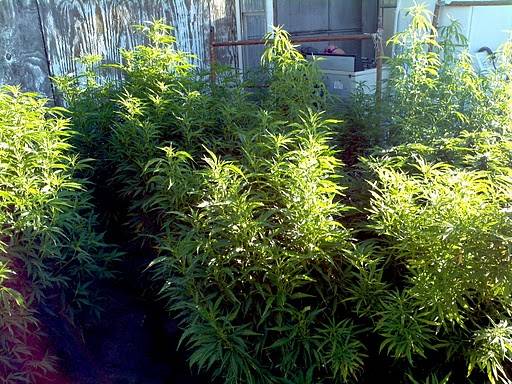me:
rrog
The rule of diversity must have some diversity within itself.
What better plant is there to support microlife, that has a symbiotic relationship to mj, than mj?
Our soil is mixed and supported by teas. We're not mining for nutrients with a diversity of different root systems. We have diversity in our soil to begin with. All we can do is recycle or take away from what is there. With the exception of nitrogen fixers, legumes, everything else is primarily nonbeneficial competition, especially in a pot situation. Legumes are best cut and chopped and used in rotation. Often they call for inoculates themselves.
Deterring pests is another reasoning behind using certain plants, though it is better when they are kept to the perimeter and in separate pots where they don't compete.
These have minimal footspace, around a square foot each, Trunks bigger than my wrist.

There has been research, I remember reading, suggesting the advantages of a shared root system in growing mj. I won't cite it because I don't remember where it came from. I think I first read it here.
From trying it in various ways, I feel there is some fact to the research. It makes a good companion to itself. Otherwise it likes it's space.
In nature, you see patches of monoculture. When there is close companionship among species, such as in a pot, it's 1 plant dominating the other. A host and a predator.
rrog
Surfer seems to do pretty well if I recall.Surfer shares his soil with multiple MJ. I had a thread a while back and most guys were strongly opposed to sharing the soil with more than 1 MJ.
Just an opinion, but when in doubt diversity seems like the way to go. Seems that's the way it is when looking at other aspects of growing
The rule of diversity must have some diversity within itself.
What better plant is there to support microlife, that has a symbiotic relationship to mj, than mj?
Our soil is mixed and supported by teas. We're not mining for nutrients with a diversity of different root systems. We have diversity in our soil to begin with. All we can do is recycle or take away from what is there. With the exception of nitrogen fixers, legumes, everything else is primarily nonbeneficial competition, especially in a pot situation. Legumes are best cut and chopped and used in rotation. Often they call for inoculates themselves.
Deterring pests is another reasoning behind using certain plants, though it is better when they are kept to the perimeter and in separate pots where they don't compete.
These have minimal footspace, around a square foot each, Trunks bigger than my wrist.


